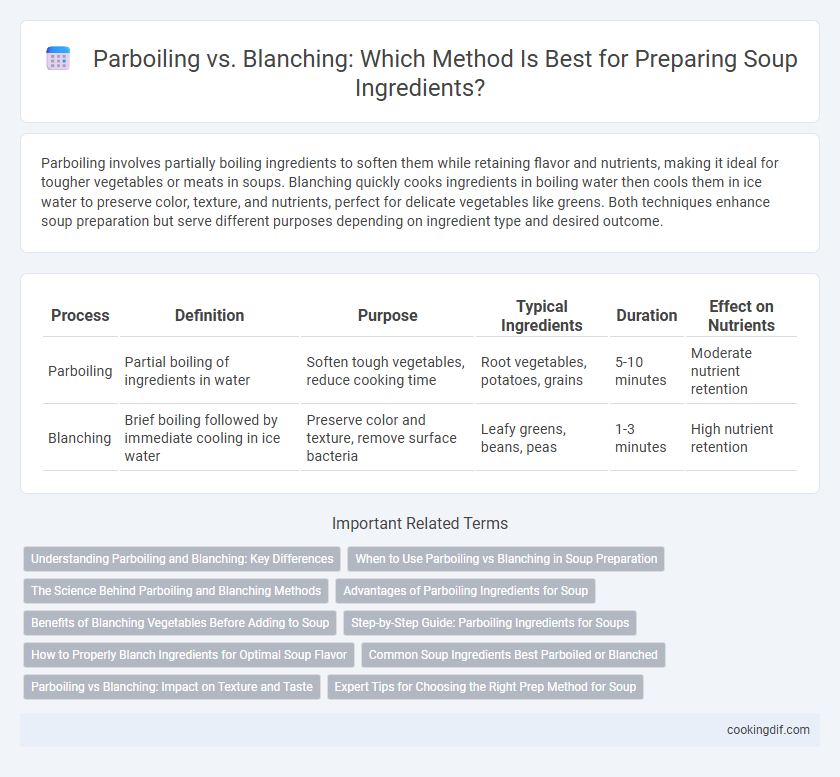Parboiling involves partially boiling ingredients to soften them while retaining flavor and nutrients, making it ideal for tougher vegetables or meats in soups. Blanching quickly cooks ingredients in boiling water then cools them in ice water to preserve color, texture, and nutrients, perfect for delicate vegetables like greens. Both techniques enhance soup preparation but serve different purposes depending on ingredient type and desired outcome.
Table of Comparison
| Process | Definition | Purpose | Typical Ingredients | Duration | Effect on Nutrients |
|---|---|---|---|---|---|
| Parboiling | Partial boiling of ingredients in water | Soften tough vegetables, reduce cooking time | Root vegetables, potatoes, grains | 5-10 minutes | Moderate nutrient retention |
| Blanching | Brief boiling followed by immediate cooling in ice water | Preserve color and texture, remove surface bacteria | Leafy greens, beans, peas | 1-3 minutes | High nutrient retention |
Understanding Parboiling and Blanching: Key Differences
Parboiling involves partially boiling ingredients like vegetables or grains to soften them before finishing cooking, which helps retain texture and reduce cooking time. Blanching is a brief boil followed by immediate cooling in ice water, primarily used to preserve color, flavor, and nutritional value while halting enzyme action. Understanding these processes enhances soup preparation by ensuring optimal ingredient texture and nutrient retention.
When to Use Parboiling vs Blanching in Soup Preparation
Parboiling is ideal for tough vegetables like potatoes or root vegetables that require partial cooking to soften before adding to soup, ensuring even texture without overcooking. Blanching works best for leafy greens and delicate vegetables to preserve color and flavor by briefly boiling then plunging in ice water. Choose parboiling to reduce overall cooking time and blanching to maintain visual appeal and nutrient retention in soups.
The Science Behind Parboiling and Blanching Methods
Parboiling involves partially boiling ingredients to soften them while preserving texture and nutrients by halting enzymatic activity through heat. Blanching rapidly immerses vegetables in boiling water followed by an ice bath, effectively destroying enzymes that cause spoilage and color loss. Both techniques optimize ingredient texture and shelf life in soup preparation by controlling enzyme activity and nutrient retention.
Advantages of Parboiling Ingredients for Soup
Parboiling ingredients for soup helps retain more nutrients compared to blanching by partially cooking vegetables and boiling away impurities. This method softens tough ingredients evenly, reducing overall cooking time and enhancing the soup's flavor profile. Parboiling also prevents overcooking during the final simmer, maintaining texture and visual appeal in the finished dish.
Benefits of Blanching Vegetables Before Adding to Soup
Blanching vegetables before adding them to soup preserves their vibrant color, texture, and nutritional value by halting enzyme activity that causes deterioration. This process also removes surface dirt and reduces bitterness, resulting in a cleaner, more flavorful broth. Moreover, blanching slightly softens vegetables, ensuring even cooking and enhanced integration of flavors in the final dish.
Step-by-Step Guide: Parboiling Ingredients for Soups
Parboiling ingredients for soups involves partially boiling vegetables or meats to soften them before fully cooking in the soup, which enhances texture and flavor absorption. Start by bringing a pot of water to a boil, then add the ingredients and cook for 2-5 minutes depending on size and type, ensuring they remain slightly firm. Drain the ingredients immediately and transfer them to the soup base, allowing them to finish cooking and infuse the broth with richer flavors.
How to Properly Blanch Ingredients for Optimal Soup Flavor
To properly blanch ingredients for optimal soup flavor, boil vegetables briefly in salted water for one to three minutes, then immediately plunge them into ice water to halt the cooking process and preserve color and texture. This technique enhances the soup's flavor by softening vegetables without overcooking, maintaining their vibrant taste and nutrients. Parboiling differs by partially cooking ingredients longer, which can lead to flavor loss, making blanching the preferred method for fresh, crisp soup components.
Common Soup Ingredients Best Parboiled or Blanched
Carrots and potatoes benefit from parboiling to partially soften them while preserving texture and nutrients for soups. Green beans and spinach are best blanched to retain vibrant color and minimize nutrient loss before adding to broth. Parboiling and blanching both enhance cooking efficiency but are selectively applied based on ingredient type and desired soup consistency.
Parboiling vs Blanching: Impact on Texture and Taste
Parboiling involves partially cooking ingredients in boiling water to soften them while retaining structure, resulting in a tender texture ideal for soups needing prolonged simmering. Blanching, a quick boil followed by immediate cooling in ice water, preserves vibrant color, firmness, and subtle flavors by halting the cooking process rapidly. Understanding the differences in heat exposure and timing between parboiling and blanching allows chefs to control ingredient texture and taste for optimal soup consistency and flavor development.
Expert Tips for Choosing the Right Prep Method for Soup
Parboiling retains more nutrients and partially cooks tougher vegetables, making it ideal for hearty soups that require extended simmering. Blanching quickly softens ingredients and preserves vibrant color and texture, perfect for fresh vegetable soups or when ingredients are added later in cooking. Expert chefs recommend selecting parboiling for root vegetables and beans, while blanching suits leafy greens and delicate legumes to optimize flavor and consistency in soup preparation.
parboiling vs blanching for prepping ingredients Infographic

 cookingdif.com
cookingdif.com